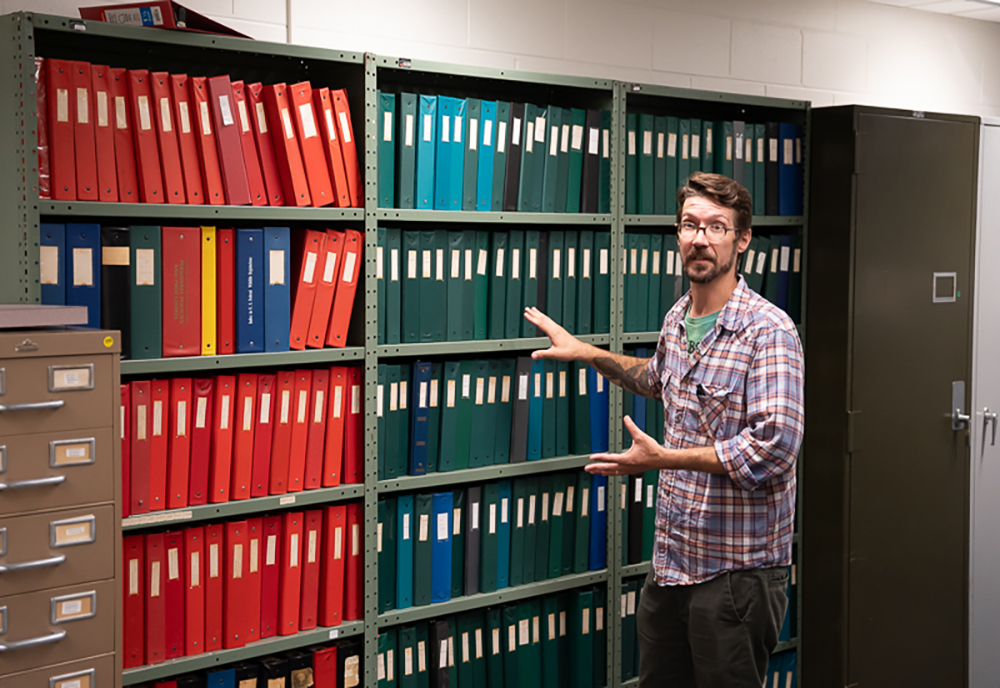By Kellie Britch, College of Arts and Sciences
It’s no secret that the USF Libraries house invaluable archives for students and researchers alike. Now, in the library basement, you can find a different kind of collection — the USF Herbarium.
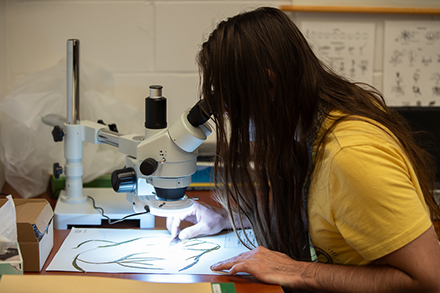
Kyle Keefer, an undergraduate student and herbarium assistant, examines new specimens to aid in the identification and documentation of new donations to the collection. (Photo by Corey Lepak)
The USF Herbarium was founded in 1958 and was first housed on campus in the John and
Grace Allen building. Through the work of USF Faculty and students, this is one of
the most complete collections of central and northern Florida plants in the United
States and the second largest collection in Florida. It boasts more than 300,000 specimens
of vascular plants housed in 280 steel cases in addition to thousands of specimens
of algae, mosses, liverworts and fungi. This collection also includes more than 5,000
archival resources including rare manuscripts, periodicals and books focused on botany.
“Everyone knows about libraries,” said Frank Almeda, who is a USF alumnus, former
research assistant in the USF Herbarium and curator emeritus at the California Academy
of Sciences. “Well, herbaria are essentially libraries of plant diversity. They are
virtual treasure troves of plant life on our planet and secure repositories of our
natural heritage.”
For botanists, researchers and enthusiasts, collections like the one at USF are critical
for a number of reasons:
- Researchers rely on herbaria to help identify plants so that they can work to create future medicines.
- Land managers use the collections and expertise from herbaria to confirm the identification of plants from areas managed by municipal, county, state and federal entities.
- As new species are discovered, scholars scrutinize the specimen using herbaria, and then either validate or reject the claims.
- Because herbaria hold location data for all the specimens in their collections, they can document the movements of introduced and native plants as they adapt to changes in their environments. Herbaria provide a detailed record of where plants once grew, providing a roadmap for conservation and restoration efforts.
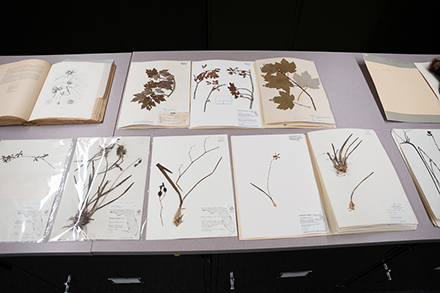
The USF Herbarium strives to get the whole part of each plant – seeds, roots, leaves and flowers. (Photo by Corey Lepak)
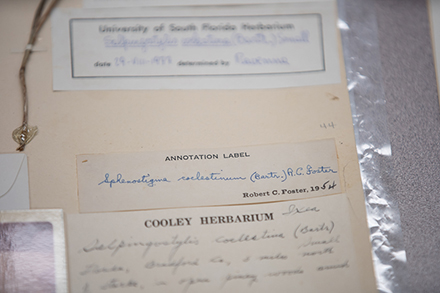
Established in 1958, the USF Herbarium’s collection serves as an invaluable snapshot of the ecological changes that have occurred over the better part of a century. (Photo by Corey Lepak)
“While the work we do is focused on plants, the most important reasons for doing this
work are in service of people,” said Christopher Kiahtipes, curator of the USF Herbarium. “We help people learn about the amazing world of plants
and all the ways they shape our lives.”
Specimens are preserved by pressing, drying and mounting them on archival paper. After
the specimens are databased and added to the physical collection, student workers
take high-resolution digital photos of the specimens which are uploaded with the databased
records to the Atlas of Florida Plants. Frequented by over 230,000 users last year, the online database is an invaluable
resource.
With more than 300,000 specimens and hundreds of new specimens arriving over the last
year, digitization of the collection is a big responsibility — one that would be impossible
if it weren’t for USF’s students working in the Herbarium.
“One of the most important parts of the USF Herbarium is how it supports student workers,
giving them valuable experience, encouraging them to gain expertise in the world of
botany and helping them develop skills that are valuable in any part of the workforce,”
said Kiahtipes. “This includes everything from managing large datasets, digitization
and even interacting with the public.”
The USF Herbarium leaves a lasting impact on the students who work there. Anita Crnjac,
who is set to graduate this fall with a master’s degree in nanomedicine from USF’s
Taneja College of Pharmacy, says that starting to volunteer with the Herbarium five years ago has changed the
trajectory not only of her passion, but also of her career.
“When I went into undergrad, my goal was to eventually apply for PA school,” said
Crnjac, who will be starting a full-time role as a curator’s assistant at the USF
Herbarium after graduation. “Then I took a medical botany course and started working at the Herbarium, and it made me pivot. I still want to
do medicine, but now I want to pursue medicinal research with a plant focus.”
In March 2024, energized by a generous gift from Drs. John and Kathleen Burt-Utley,
who are retired researchers through the Institute for Systematic Botany, Kiahtipes
oversaw a blooming partnership between the USF College of Arts & Sciences, the Department of Molecular Biosciences and the USF Libraries through the transfer of the collection from the CAS Multidisciplinary
Complex (CMC) building to its new home in the USF Tampa Library. Placing the herbarium
in the library enhances its accessibility and visibility, encouraging interdisciplinary
use of the collections.
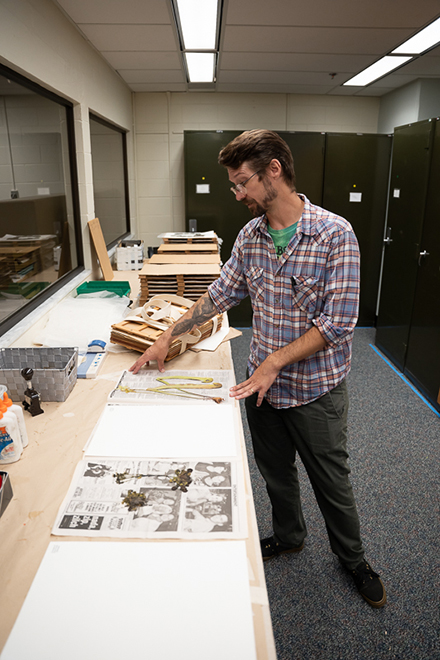
Botanists, researchers and enthusiasts send their samples to the USF Herbarium to identify and preserve. (Photo by Corey Lepak)
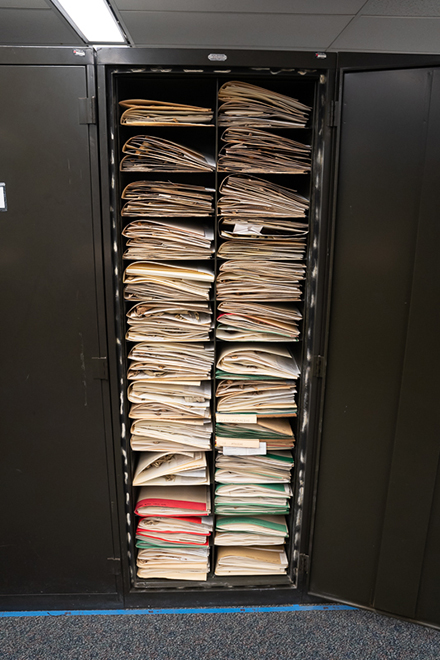
The USF Herbarium consists of 280 steel cases, each filled with preserved plants and their identifying information. (Photo by Corey Lepak)
According to Kiahtipes, the move was a collaborative effort between staff, faculty and students across organizational units and academic departments.
“Support from the College of Arts and Sciences, the USF Libraries and donors like
the Almedas and Utleys help us purchase supplies and equipment that we need to do
the basic work of preserving, cataloging and storing this collection,” said Kiahtipes.
“Of course, one of the most significant needs is support for student workers and staff.
None of this is possible without the dynamic team of people that have come together
recently to make this happen.”
Support the USF Herbarium.
